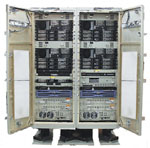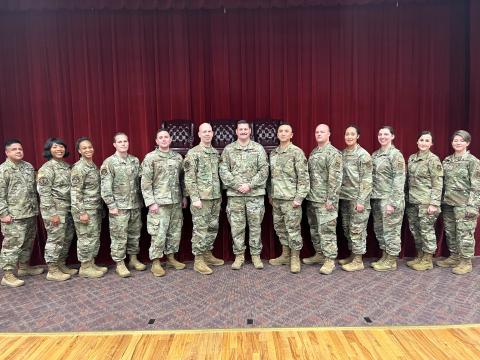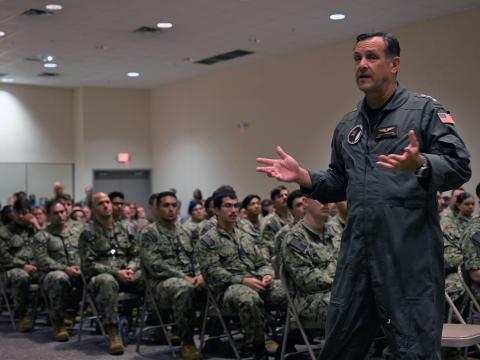Coalition Environments Challenge Communications Strategy
Multinational partnerships depend on responsive information flow and quickly deployable secure infrastructures. 
The box and attached dome near the front of this Pakistani ship is a flyaway kit, which provides basic coalition network and voice connectivity.
The U.S. Navy’s Combined Enterprise Regional Information Exchange System–Maritime is part of a multinational initiative supporting information exchange among coalition partners. Successful coalition communications systems must be built around capabilities that allow a responsive flow of information without violating the trust or compromising the security interests of participating nations.
Multinational collaboration requires both structured and unstructured methods at varying levels of security. The architecture must accommodate features in an approach that is scalable, supportable and achievable from an engineering, security and acquisition perspective.
The Combined Enterprise Regional Information Exchange System–Maritime (CENTRIXS-M) enables sailors to share information via the Web, e-mail messages or chat applications with other ships in company and with any coalition force that has installed a similar capability on its own ships. Commanders at sea, working closely with fleet and force commanders in theater, can ensure that all member nations of a coalition force have access to a common capability and data set, or enclave, and that all forces have access to critical, time-sensitive planning and support data necessary to carry out the mission. There are several different enclaves throughout the world, and depending on the mission and requirements,
This coalition capability brings with it some simple, effective tools for the warfighter. Commanders at sea and ashore can engage in chat sessions with any or all coalition partners. Operations, communications and support personnel all have access to the chat capabilities in the enclave, allowing virtually any type of information to be exchanged. Time-sensitive and support data can be collaboratively shared, enabling the entire force to communicate with the same information as a foundation. E-mail messages can be exchanged between any of the users in the enclave.
The diverse nature of a coalition’s communications capability often makes uniform data transmission difficult. Efficient use of existing bandwidth will help bridge the gap. Many of the systems employed in today’s operations remain stand-alone, especially at the tactical level. The Joint Tactical Radio System (JTRS) is a key enabler toward outfitting tactical users with network-centric capability. JTRS will deliver modern hardware and networking waveforms specifically designed for the tactical user. Over time, coalition connectivity speeds will increase beyond those available at high-frequency and very-high-frequency bands. Because communications will be networked instead of stand-alone, new capabilities will emerge beyond what is available now.
Protecting the security and confidentiality requirement of each partner is a key ingredient in the success of the coalition. Using the CENTRIXS-M infrastructure, information approved for release can be replicated into an enclave from another security domain for use by all partners in that enclave. Enclave users have access to all of the information being shared in the enclave, but they do not have access to the data in other enclaves unless they have access to U.S. Navy networks. Data integrity is protected by the
CENTRIXS-M has widespread availability. It is installed on the majority of U.S. Navy combat and supply ships as the common infrastructure supporting the information exchange among coalition partners.
The
Creating a cohesive global maritime security force involves increasing
Policies and cooperation will enable interoperability across service, department and geopolitical boundaries by establishing agreements on information earmarking and classification and processes for access. Effective information exchange and interoperability, including identification of the proper protocols, often are defined in an information exchange agreement between global partners.
 |
| The Combined Enterprise Regional Information Exchange System–Maritime (CENTRIXS-M) enables sailors to share information with any coalition force that has installed a similar capability on its ships. |
One solution frequently used by the fleet and theater commanders is to deploy a flyaway kit capability that affords any member nation participating in a coalition operation the ability to collaborate with all other coalition partners. Commanders successfully have fielded flyaway kits on a temporary basis within the Pacific area to support multinational operations. Flyaway kits enable a coalition partner that does not possess an indigenous capability for network-based command and control to receive that capability to support any type of operation. Once the operation has concluded, the flyaway kit is returned to the theater commander.
The data being shared among the partners must reach beyond tactical military information. Commercial logistics providers and a myriad of medical providers likely will have critical data to share with operational forces as well. It is difficult to define the complete set of operational partners for coalition operations, and it is highly likely that the list will be forever evolving to include new participants and to remove those unnecessary for a given operation.
Moving forward, the Defense Department must investigate and exploit promising new technologies, seek new data sources such as unclassified ship and cargo data and perfect the means to share that information with the greater maritime security community of interest at the lowest possible classification level.
An increased emphasis on the integration of the various functions of command, control, communications, computers, intelligence, surveillance and reconnaissance (C4ISR) as an effective force multiplier is driving the need for new and advanced technologies. Technological enhancements and cooperative information sharing include the ability to exchange relevant information across networked military, government and private organizations. In the exchange of information, sharing at the unclassified or lowest classification level offers the highest benefit in terms of gaining trust and substantive cooperation from a wide range of international partners.
However, the technology gap between potential coalition partners continues to widen. Recent studies project that many home users will have 250 times more bandwidth than a fully equipped guided missile destroyer by 2014. Additionally, the U.S. Army’s Future Combat Systems is predicting that more than 10 megabits per second will be available to the warfighter, while current bandwidth among many coalition partners ranges from zero to the low kilobits per second.
The demand for Web service capabilities to support warfighting continues to explode. Web services, collaboration tools, Internet protocol version 6, data handling and storage, and security all are top industry investment areas. Breakthroughs in related technologies such as improved battery size and life, nanocomputing and wireless technologies may allow the vision of truly mobile, tactical handheld and person-wearable systems to come to fruition.
Regardless of the mission, the coalition tactical user will be forced to contend with technical and programmatic challenges. The speed of technology development can outpace some countries’ abilities to procure and field new hardware and software. In addition, acquisition program guidelines present challenges that must be addressed to ensure the proper application of funding to validated requirements.
Another concern is that the demand for the flyaway kit capability is increasing as the number of coalition partners in global maritime operations increases. Also of concern is the fact that the provisioning of support and training often can suffer as a result of continually fielding new and improved capabilities.
Language translation that preserves the intent of the messages sent and received remains a critical part of meeting the challenges of coalition operations.
The increased need for collaboration between non-U.S. and
Combined with the
Only the global community can assure true security, freedom and prosperity. Protecting the freedom of the seas and the integrity of international borders will require more capacity than any one nation can provide. This means that the Defense Department, the U.S. Department of Homeland Security, coalition partners and their industrial associates must develop the partnerships, protocols and procedures that will permit nations with similar goals to cooperate for the common good. Current and emerging C4ISR technologies can make the difference between mission success and failure as interested nations increase their capacity to work together in supporting the global maritime security force.
Robert Ducote is the afloat networks in-service engineering project manager, Space and Naval Warfare (SPAWAR) Systems Center,
Also contributing from
Web Resource



